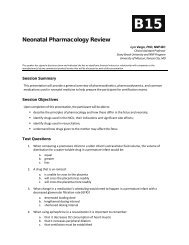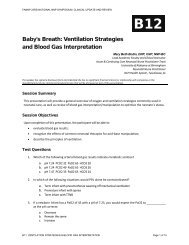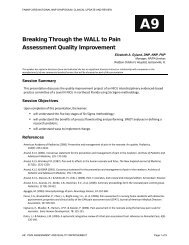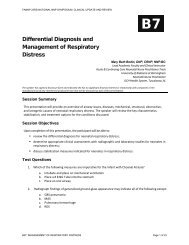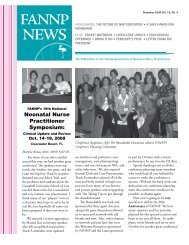Out for Blood: Neonatal Hematology Review - FANNP
Out for Blood: Neonatal Hematology Review - FANNP
Out for Blood: Neonatal Hematology Review - FANNP
Create successful ePaper yourself
Turn your PDF publications into a flip-book with our unique Google optimized e-Paper software.
<strong>FANNP</strong> 23RD NATIONAL NNP SYMPOSIUM: CLINICAL UPDATE AND REVIEWAnemia – Causes of Hemolysis◦ What to look <strong>for</strong>…ABO incompatibility• Mild hemolysis• Anemia• Reticulocytosist i• HyperbilirubinemiaAnemia – Causes of Hemolysis◦ How to Treat ABO and Rh Incompatibilities• RhoGAM Rh Negative ONLY◦ Prophylactic anti-D immune globulin◦ Blocks maternal antibody production bydestroying fetal red cells in maternal circulation◦ Given at ~28 weeks, then again within 72 hoursfollowing delivery and anytime there may befetal-maternal blood mixing in Rh – pregnantwomen• Phototherapy• Good hydration• IVIG (intravenous immunoglobulin) 1 g/kg over 4hrs• Consider blood or exchange transfusion• Management of multisystem dysfunctionAnemia – Causes of HemolysisNo matter the antibody...Hemolysis will continue until all antibodyinhabited cells are destroyed…that can meanup to months depending on degree ofantibody presence◦ Enzymatic Defect• G6PD (glucose-6-phosphatedehydrogenase) Deficiency• Most common inherited red cell disorder◦ Sex-linked, mainly male offspring,occasional female carriers◦ Most common in American black infants(10% to 15%), also Mediterranean, African,Asian decent• How does it happen?◦ Hemolysis & shortened erythrocyte life dueto deficiency of red cell enzyme & exposureto antioxidant stress (drugs, infection)Anemia – Causes of Hemolysis◦ Infection• Intrauterine◦ Congenital TORCH infections• Toxoplasmosis• Other h (syphilis, hepatitis i B, coxsackievirus,iEpstein-Barr, varicella-zoster Virus, parvovirus)• Rubella• Cytomegalovirus• Herpes Simplex Virus• Postnatal◦ Bacterial infections• Both may cause…◦ Hemolysis, anemia, thrombocytopenia, DICAnemia of Prematurity◦ Considered physiologic◦ How does it happen?• Erythropoietin falls to minimal level d/t improvedrelative oxygenation after birth• Hgb falls by 1 g/dL/week in preterm infants,starting at~2 weeks of age to an average nadir of7-9 g/dL at 6 to 8 weeks of life◦ Smaller & more immature infants will reachlower nadir at an earlier age d/t shortened RBClife span◦ Transfusions result in a greater fall in Hgb d/tpresence of HbA, will still undergo nadir◦ Premature infants have persistent hepaticpathway◦ The ensuing anemia triggers a hypoxic stimulus,thus increasing the presence erythropoietin andultimately RBC productionB14: NEONATAL HEMATOLOGY REVIEW Page 8 of 22



